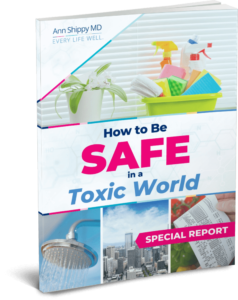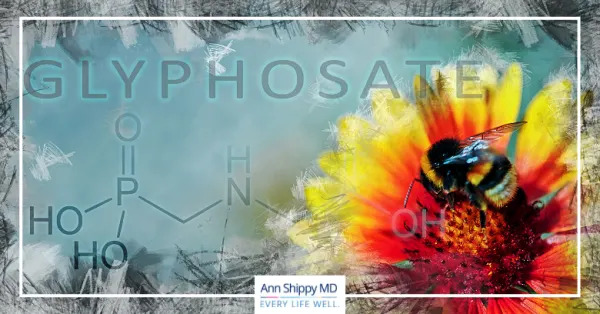Glyphosate Cancer – Monsanto Roundup Lawsuit – Carcinogens
Our health and the health of the planet are intricately linked and are so very dependent upon the health of the soil. One of the biggest environmental and health crises we face today is the loss of soil fertility.
Just as we need a diverse and balanced microbial community in our gut, we also need it in the soil, which gives life to the food we eat.
A large contributor to the loss of soil health and human health is the use of herbicides and other chemicals in industrial agriculture. Not only does this practice decrease the nutrient density of our food and wreak havoc on the environment, but these chemicals threaten human health as well and can cause cancer.
Today’s article focuses on just one chemical: glyphosate. Glyphosate is the active ingredient in Monsanto’s Roundup products.
You may even have some in your garage, ready to spray on the weeds that pop up in your yard or in the sidewalk cracks. After reading this, you may think twice.
As always, the goal of this article is to provide education, research and information along with action steps to improve the health of your environment and ultimately of your body.
Keep reading to learn more about:
- What is glyphosate?
- The health effects related to glyphosate exposure
- How California is addressing glyphosate cancer concerns
- Glyphosate in food
- Action steps to begin taking now
What Is Glyphosate?
Glyphosate is a broad-spectrum herbicide that was first sold to farmers in 1974. Broad spectrum simply means that glyphosate doesn’t discriminate. Because it deactivates an important enzyme in plants, it will kill whatever plant it comes in contact with.
Today, it’s the most heavily applied herbicide globally and levels of use rise each year. In 2014, 240 million pounds of glyphosate were sprayed on US crops. It’s estimated that over 4.5 billion pounds of glyphosate are currently in the global environment.
Glyphosate is the active ingredient in the Roundup herbicide made by Monsanto. Monsanto is also responsible for developing genetically modified (GMO) crops that are “Roundup ready.”
By genetically altering the seeds for corn, soy, canola and other crops, Roundup is sprayed on the entire crop, but the crop lives and the weeds die. GMO crops have been in the food supply since the 1990s, when glyphosate use really skyrocketed.
But, glyphosate isn’t confined to just the food it is sprayed on. It doesn’t break down easily and persists in the environment. Glyphosate is found in groundwater, drinking water, the air and in the soil. It doesn’t just create a residue on food that can be washed off; it’s incorporated into the plants.
Since so many food products in this country are made with corn and soy, processed foods are one of the largest sources of glyphosate in the diet.
Just as bacteria adapt to antibiotics and become more resistant over time, plants become resistant to herbicides. As glyphosate resistance increases, more is applied to crops, year after year.
Interestingly, the yields of corn, soy and cotton in the US have not increased with the introduction of Roundup, GMOs and other modern agricultural practices, but the costs to farmers – and all of us – certainly have risen.
Because Roundup contains other chemicals and additives in addition to glyphosate, Roundup is actually more toxic than glyphosate itself. One study showed that when mixed with the other components in Roundup, glyphosate amplifies the toxicity of their active constituents up to a thousand times, in all cases!
Further, much of the research on the impacts to human health centers on glyphosate and doesn’t take into account the overall load of toxins we are exposed to in our environment and over a lifetime.
Health Effects – What Does Glyphosate Do To Humans?
There is no doubt that glyphosate is toxic to the environment. Its persistence throughout the world is linked to declines in honey bees, frogs, fish and other wildlife and acts like an antibiotic for the soil, decreasing the natural abundance and diversity of microorganisms.
It’s impossible to say that a chemical affects the environment, but doesn’t affect humans even though this is the common argument that you will hear, largely from the herbicide industry itself.
The evidence against the use of glyphosate is mounting as we learn more about what it does in the body.
We know that glyphosate negatively affects the human microbiome, acting just as it does in the soil. We have evidence glyphosate not only inhibits beneficial bacteria, but it even increases pathogens.
Since the microbiome is foundational for the health of the whole system, this disruption may have far reaching consequences in the body.
Glyphosate also has many other undesirable impacts as well:
- Damages the mitochondria, the energy producers of the cells
- Promotes oxidative stress
- Disrupts hormone signaling
- Chelates minerals, contributing to nutrient deficiencies
- Inhibits detoxification
- Adds to the total body burden of chemicals
All of this adds stress to the body. We might not typically think of chemicals as a source of stress, but these hidden stressors wreak havoc on the HPA-axis, creating imbalance in the brain hormones that send signals to the adrenal and other glands in the body.
Symptoms of HPA Axis dysfunction and burnout including fatigue, sleep issues and blood sugar issues almost always have an underlying factor involving toxicity.
Glyphosate is now categorized as a “probable human carcinogen” as a growing body of research links glyphosate with various types of cancer. Correlations between glyphosate and chronic kidney disease, birth defects, autism and infertility have also been made.
While some of us may be more susceptible to the effects of glyphosate, for genetic or epigenetic reasons, this is a chemical that we are all exposed to and can’t escape. It’s affecting the soil, honey bees and the basic framework of our food system that humans need for survival.
Glyphosate certainly contributes to the overall toxic burden that we face and may help to explain the declining health that we’ve seen as glyphosate levels (and overall chemical use) has increased over the last decades.
Let’s talk about what we can do.
What Is Being Done In California – The Monsanto Roundup Lawsuit
Before we talk about what each of us, as individuals can implement into our lives to protect ourselves and our families from the health effects of glyphosate, let’s look at what is being done on a larger scale.
California recently became the first state to require labeling that links Roundup to health risks. This is a huge victory as it allows consumers informed choice, in contrast to so many laws designed to protect the chemical industry.
In January of 2019, the California Superior Court ruled that lawmakers can require Monsanto to label Roundup as a “possible carcinogen,” similar to the labels found on cigarettes.
Proposition 65 is a California law that requires labels to list ingredients that are known to cause cancer.
Now glyphosate is added to the list that includes heavy metals such as cadmium, dyes, DDT, PFAS, benzene and hundreds of other chemicals produced by industry and brought into our homes.
Of course, Monsanto is fighting back through the courts, claiming that Roundup poses no risks to humans. Farmers, academics, researchers, scientists, food industry reformers, politicians and citizens continue to present the overwhelming evidence against glyphosate.
Nevertheless, the move by California to label glyphosate from Monsanto roundup as a carcinogen is a step toward banning lethal chemicals and protecting the health of the planet and us all. Now, it’s time for other states to follow suit.
Glyphosate In Food
Reducing our exposures to glyphosate in food is incredibly important, as these are the most concentrated sources of glyphosate that we are exposed to. Glyphosate, as Roundup, is most commonly sprayed on the following crops:
- Corn (GMO)
- Soy (GMO)
- Canola/Grapeseed (GMO)
- Wheat
- Barley
- Beans
While wheat isn’t genetically modified to resist glyphosate, wheat and other grain crops are typically heavily sprayed in the days and weeks before harvest to accelerate the harvesting process.
These late season applications may lead to more glyphosate residues on these grains. Glyphosate use in agriculture is a proposed reason that we are seeing a rise in celiac disease as well as non-celiac gluten sensitivity.
In addition, it’s important to mention that meat, dairy and eggs are also high in glyphosate when the animals are fed diets of conventional corn and soy because the glyphosate accumulates in the animal.
And processed foods, as mentioned earlier, are another concentrated source as many contain high fructose corn syrup, soy protein, flour and other derivatives of corn, soy and wheat.
Action Steps
In addition to avoiding GMO foods and other high glyphosate foods, here are some other tips for reducing exposure in order to improve health and prevent disease:
1. Eat a Paleo diet. A Paleo diet naturally removes high glyphosate grains and legumes and provides nutrient-density to promote detoxification. By focusing on quality animal protein, nutritious fats and an abundance of plant foods, you provide the antioxidants and micronutrients that your cells need to help protect you from the glyphosate exposures that you cannot control.
2. Choose organic. If it’s organic, it’s GMO-free and you know that glyphosate wasn’t used in the production of that food. Organic meat, dairy and eggs come from animals fed organic and GMO-free feed. Organic plant foods were grown without the use of pesticides and herbicides.
3. Go beyond organic. Support small farmers in your local area that are tending to the health and wellness of the soil. Choose to support regenerative agriculture, where farmers use grazing practices to build soil fertility.
4. Filter your water. Since glyphosate enters the global water system, it is likely that there is some in your drinking water. A high quality water filter will remove glyphosate and other chemicals from your drinking water.
5. Support your microbiome. Give your gut bugs some extra love by eating fermented foods, fiber-rich fruits and vegetables, colorful produce and even adding in a probiotic supplement or other digestive support.
6. Support your detoxification pathways. While ultimately it is essential to reduce your exposure to as many toxins as possible, it’s impossible to avoid them all. Build resiliency in your system by having well-functioning detoxification pathways, here’s how.
7. Ban glyphosate. Support efforts to ban glyphosate in your neighborhood, city, state and ultimately throughout the US and world. Portland, Oregon Department of Parks and Rec declared it will discontinue glyphosate use within the city, citing evidence to the environmental and human health consequences. Mexico recently released its plan to phase out glyphosate by 2024. This is great news for the world!
Glyphosate is a chemical that’s been around for decades and continues to be used in abundance, however, the tides are beginning to turn. Communities are looking to alternatives for weed control in lieu of spraying glyphosate in public parks, schools, roadways and other areas.
When it comes to agriculture, there is also a movement, especially among young farmers to return to more traditional methods of growing food. With increased awareness, more consumers are seeking out local, organic and higher quality products.
The choices we make each day protect our health and have ripple effects out in the world. When we have more information, we make better choices and influence our circles. All of this is hopeful for a brighter and less-toxic future, for our children and the earth. It all starts with the soil.

References
- https://www.ncbi.nlm.nih.gov/pmc/articles/PMC4756530/
- https://pubmed.ncbi.nlm.nih.gov/27541149/
- https://pubmed.ncbi.nlm.nih.gov/28643882/
- https://www.ncbi.nlm.nih.gov/pmc/articles/PMC1257596/
- https://pubmed.ncbi.nlm.nih.gov/29117584/
- https://pubmed.ncbi.nlm.nih.gov/25407376/
- https://www.ncbi.nlm.nih.gov/pmc/articles/PMC3955666/
- https://pubmed.ncbi.nlm.nih.gov/25801782/
- https://pubmed.ncbi.nlm.nih.gov/15182708/
- https://pubmed.ncbi.nlm.nih.gov/27780120/
- https://www.ncbi.nlm.nih.gov/pmc/articles/PMC4417209/
- https://www.ncbi.nlm.nih.gov/pmc/articles/PMC1241196/
- https://pubmed.ncbi.nlm.nih.gov/19672763/
- https://pubmed.ncbi.nlm.nih.gov/26826339/
- https://pag.confex.com/pag/xxiv/webprogram/Paper21483.html
- https://www.ncbi.nlm.nih.gov/pmc/articles/PMC3945755/















